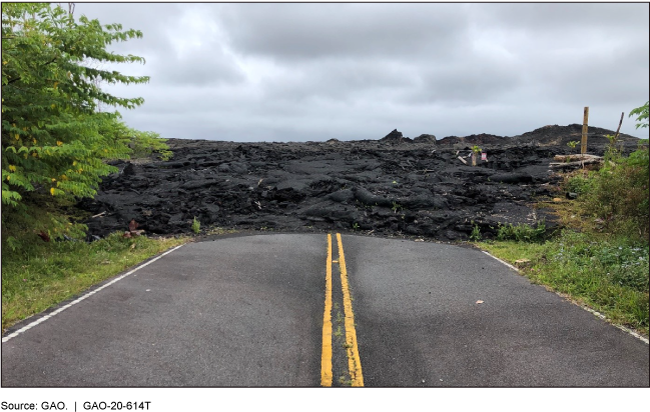2018 Pacific Disasters: Preliminary Observations on FEMA’s Disaster Response and Recovery Efforts
Fast Facts
Hawaii and the U.S. Pacific-area territories had a record number of natural disasters—typhoons, earthquakes, mudslides, and volcanic eruptions—in 2018. As of May 2020, they used about 63% of the $788 million in Disaster Relief Funds obligated for the disasters.
Based on initial observations, local officials believe FEMA’s disaster response was fairly effective. But contracting problems, workforce shortages, and cost disagreements hindered certain recovery efforts. For example, FEMA disagreed with some island officials’ cost estimates for transporting goods to the remote region, delaying certain projects.
Hardened Lava Blocking a Road in Hawaii

Road blocked by lava
Highlights
What GAO Found
The Federal Emergency Management Agency (FEMA) obligated about $788 million in disaster assistance, as of May 2020, to the Commonwealth of the Northern Mariana Islands (CNMI), Guam, and Hawaii for response and recovery efforts following the 2018 disasters—most of which went to the CNMI. About $541 million (69 percent) of these obligations went to recovery projects in the CNMI, Guam, and Hawaii, such as debris removal and bridge and utility repair. FEMA estimates it will obligate an additional $94 million in grants to be provided directly to the CNMI and Hawaii through September 2020.
Local officials GAO spoke with considered FEMA's response to the 2018 Pacific disasters to be generally effective, but it is not clear if FEMA's response procedures are well-suited for slow-moving disasters, such as volcanic eruptions. Specifically, FEMA reported taking steps prior to 2018 to improve its response capabilities in the region, such as completing catastrophic disaster plans with the CNMI and Guam and increasing the capacity of its two Pacific area distribution supply centers. Officials also told GAO that FEMA was an effective partner that led a unified, coordinated response effort. However, FEMA procedures may not be well-suited for slow-moving disasters, such as a volcanic eruption in Hawaii, which, according to Hawaii officials, resulted in FEMA starting recovery efforts before response activities were completed.
Damage from Typhoon Yutu in the Commonwealth of the Northern Mariana Islands (left) and the Kilauea Volcano Eruption in Hawaii (right)

GAO's preliminary analysis identified several challenges affecting FEMA's recovery efforts in the CNMI, Guam, and Hawaii. Specifically, CNMI and Hawaii officials noted that disagreements with FEMA over the accuracy of estimates for certain fixed-cost recovery projects have delayed these projects. According to CNMI and Hawaii officials, these disagreements were caused, in part, by FEMA not accounting for higher procurement and shipping costs to the Pacific region. In addition, similar to disaster recoveries in other U.S. island territories, limited disaster workforce capacity and shortages of construction workers hindered the implementation of FEMA-funded projects in the Pacific. Lastly, contracting and construction challenges contributed to delays in the CNMI's implementation of FEMA's Permanent Housing Construction program.
Why GAO Did This Study
The CNMI, Guam, and Hawaii experienced an unprecedented number of natural disasters in 2018—including typhoons, earthquakes, mudslides, and volcanic eruptions. FEMA is the lead federal agency responsible for helping states and territories prepare for, respond to, and recover from natural disasters. Due to the remoteness of Hawaii and the Pacific territories, disaster response and recovery in the region can be challenging. Title IX of the Additional Supplemental Appropriations for Disaster Relief Act of 2019 included a provision for GAO to review FEMA's response and recovery efforts for 2018 natural disasters, including those in the Pacific region.
This statement is based on ongoing work and provides preliminary GAO observations on (1) the status of FEMA disaster assistance for the CNMI, Guam, and Hawaii as of May 2020; (2) the extent to which officials in the CNMI, Guam, and Hawaii found FEMA's response to the 2018 disasters effective; and (3) the challenges, if any, FEMA experienced implementing recovery assistance programs in these locations.
For this work, GAO analyzed program documents, catastrophic disaster plans, and data on FEMA obligations and expenditures as of May 2020; interviewed federal, state, territorial, and local officials; and visited disaster-damaged areas in Hawaii in February 2020.
GAO incorporated technical comments from FEMA on this statement, as appropriate.
GAO will continue its ongoing work and make recommendations as appropriate in the final report.
For more information, contact Christopher Currie at (404) 679-1875 or ccurrie@gao.gov.
